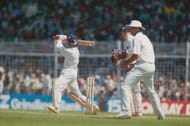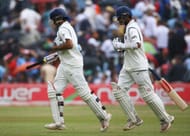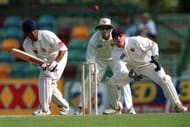Indian cricket has been known to produce some of the greatest exponents with the willow. If Sunil Gavaskar’s batting was considered a coaching manual on how to bat in the purist and technically correct manner, Sachin Tendulkar exemplified attacking stroke play with his full range of shots.
In the early 00s, India found a dashing opener in Virender Sehwag, some of the finest technicians with the willow in Gundappa Viswanathan and Rahul Dravid and magicians with the wrists in Mohammad Azharuddin and VVS Laxman.
Indian cricket witnessed a change of guard in the early 90s. With stalwarts like Sunil Gavaskar, Kapil Dev, Dilip Vengsarkar and Ravi Shastri bidding adieu to the game, the die-hard blue brigade were looking for the next big superstar to emerge from the subcontinent.
While Mohammad Azharuddin, Anil Kumble, Javagal Srinath and Ajay Jadeja certainly were talented cricketers, Indian cricket was waiting for that once in a generation player who could be in the same class as that of a Sunil Gavaskar or Kapil Dev.
There were two batting prodigies who came up the ranks from the highly competitive Mumbai cricketing circles. Both had earned a reputation of being prolific run scorers at school cricket and the duo stitched together a mammoth 664 run partnership for their school in the Harris Shield tournament.
The batting sensations carried on their run-scoring prowess into domestic cricket and became part of the star-studded Mumbai Ranji team. No further introductions required, the young Turks were Sachin Tendulkar and Vinod Kambli.
Both Sachin and Kambli were destined to reach lofty heights in their respective careers given the immense potential they had with the willow.

Sachin was the first to make his Test debut against Pakistan in 1989 and Kambli soon stepped into top-flight cricket three years later. While Sachin had proved that he belonged to the top arena post his brilliant run-scoring exploits against lethal England and Australia attacks on seaming tracks, Vinod Kambli made an emphatic entry into Test cricket in 1993 scoring a double ton against England in his maiden series.
Kambli hit a golden run of form scoring yet another double ton against Zimbabwe in his very next Test outing. The monumental double tons catapulted him to the instant limelight and was soon hailed as one of the best left-handers in world cricket.
Some experts even drew comparisons of his flamboyant batting with West Indian batting legend Brian Lara. The Indian fans were Gung Ho and a lot was expected out this talismanic Mumbaikar. Kambli carried on his purple patch with the willow scoring two more centuries on India’s tour of Sri Lanka in 1993
The mercurial left-hander was on top of the world, becoming the fastest Indian to get to the 1000 Test run milestone at that point in time. Besides his heroics at the Test level, the southpaw had also secured his place as a dependable middle-order batsman in limited overs cricket.
The elegant stroke-maker had a wide array of shots in his armoury and scored runs at a brisk pace. His high backlift and nimble footwork gave him a touch of a West Indian swagger and looked pleasing to watch. He played some match-winning knocks for India in multi-nation tournaments like the Hero Cup, Asia Cup, Wills Cup and the Singer Cup.
However, there was one chink in his batting armoury. Kambli wasn’t the best player against the short pitch or rising deliveries and was found wanting against quality pace attacks. His technical limitations soon got exposed and the left-hander had a horrid time on seaming pitches in New Zealand followed by a dismal run with the bat at home against a quality Windies pace attack of Ambrose, Walsh and Benjamin.
A spree of poor scores forced him out of the Indian Test squad. His ouster from the national team did not deter his spirits and he continued scoring heaps of runs for Mumbai at the first class level, pressing hard on the selector's doors for a comeback.

With the emergence of Sourav Ganguly and Rahul Dravid, Kambli had serious competition for a place in the Indian batting order. The formidable Indian middle order comprising of Sachin, Dravid, Azhar and even Laxman did not have a place for Kambli anymore. It indeed was a shame that at the age of only 24, a batsman of Vinod Kambli's prowess had played his last Test for India.
Kambli made the cut for India’s 1996 World Cup squad. The stylish stroke-maker made some handy contributions with the bat in the group stages, scoring a well compiled 33 against West Indies and a fluent match-winning ton against Zimbabwe. In the semi-finals against Sri Lanka, chasing a modest 252-run target, Indian batting fell like a pack of cards against the spin of Muralitharan and Jayasuriya.
At 120 for 8, a spirited Kambli was still at the crease batting on 10, hoping to pull off some kind of a miraculous chase. With the game heavily tilted in favours of Sri Lanka, the contest was unsporting interrupted by the Indian fans and the site of a tearful Kambli exiting out of the Eden Gardens was a heart-breaking moment in Indian cricket.
Many feel that the tragic semi-final defeat broke the sheer spirit of the lively character and he was never the same player. Post the 1996 World Cup, Kambli scored only three more half-centuries in 25 odd innings and eventually played his last ODI against Sri Lanka in 2000. He tried to make as many as ten comebacks into the Indian team but most of his stints were short-lived.
1024 runs at a stellar average of 54.20 with four centuries and three half-centuries is a testimony of what tectonic heights Kambli had reached in a short-lived Test career. He also compiled 2744 runs in 104 ODIs at a respectable average of 32.59. Kambli had the distinction of being part of two Indian World Cup squads (1992 and 1996) and also featured for the 'Men in Blue' in the 1998 ICC Champions Trophy.
Few can boast of hitting Shane Warne for 22 runs in an over, few cricketers have a World Cup century to their name and few could manage two successive double hundreds in Test cricket. In a short yet stellar career, Kambli had achieved many milestones, others could only dream of.

If we go into hindsight, Kambli was a touch more gifted than his illustrious counterpart Sachin. While Sachin looked more determined in his outlook, fine-tuning any technical flaws in his near to perfect batting, Kambli seemed a touch too carefree relying merely on his natural talent.
While Sachin seemed to have an untiring zeal and penchant for scoring big hundreds, Vinod was content producing one stellar knock and being complacent with some quick-fire cameos.
In a nutshell, Kambli's sea saw career is a classic case study that talent without hard work can make you shine for a brief time frame but certainly can’t put you in the league of the best. For being a top-notch sportsman at the very highest level, one has to inculcate the values of discipline, hard work and determination, which Vinod lacked for a major part of his career.
While Sachin Tendulkar went onto become arguably the greatest Indian batsman, Kambli faded away into oblivion after a glittering start to his career. The curious case of Vinod Kambli seems like an unsolved puzzle and the mercurial southpaw remains as one of Indian cricket’s biggest enigma.
Brand-new app in a brand-new avatar! Download CricRocket for fast cricket scores, rocket flicks, super notifications and much more! 🚀☄️
